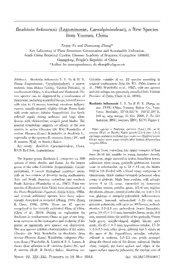
Bauhinia hekouensis (Leguminosae, Caesalpinioideae), a New Species from Yunnan, China PDF
Preview Bauhinia hekouensis (Leguminosae, Caesalpinioideae), a New Species from Yunnan, China
New Bauhinia hekouensis (Leguminosae, Caesalpinioideae), a Species from Yunnan, China * Zhang Tu and Dianxiang Tieyao Key Laboratory of Plant Resources Conservation and Sustainable Utilization, South China Botanical Garden, Chinese Academy of Sciences, Guangzhou 510650, Guangdong, Republic China People’s of * Author correspondence: [email protected] for & Abstract. Bauhinia hekouensis T. Y. Tu D. X. Clavatae consists of ca. 22 species occurring in Zhang (Leguminosae, Caesalpinioideae), a narrow tropical southeastern Asia (de Wit, 1956; Larsen et endemic from Hekou County, Yunnan Province, in al., 1980; Wunderlin et al., 1987), with one species southwestern China, described and The and one subspecies previously recorded from Yunnan is illustrated. new species can be diagnosed by a combination of Province of China (Chen 2010). et al., & Tu Bauhinia hekouensis Y. D. X. Zhang, T. sp. with nine to 11 nerves; terminal, racemose inflores- nov. TYPE: China. Yunnan: Hekou Co., Nanxi cences; spindle-shaped, slightly falcate flower buds Town, Baishahe, 22°41.237'N, 103°57.597'E, with acute apices; tubular hypanthium; five freely 169 m, near stream, 11 Oct. 2008, Tu 511 T. reflexed sepals during anthesis; and large white (holotype, IBSC; isotypes, IBSC, KUN). Figure The 1. flowers with oblanceolate, crisped petal blades. new lorphology suggests an of the affinity Wunderlin Haec Bauhmia DC. series Clavatae (de Wit) of species a coccinea (Lour.) et B. ) nervosa (Wall, ex Benth.) Baker petiolo 2.5-6 (nee 1.5-3) Phanera Wunderlin Bauhinia section (Lour.) in L., DC. and especially to the species B. coccinea (Lour.) B. nervosa (Wall, ex Benth.) Baker. Key words: Bauhinia, Caesalpinioideae, China, IUCN Red List, Leguminosae. Large liana, extending into upper canopies of host The legume genus Bauhinia L. comprises ca. 300 pubescent, singly inserted at nodes; branchlets terete, species of trees, shrubs, and lianas. As the largest pubescent when young, gradually glabrescent. Leaves X genus of the tribe Cercideae (Leguminosae, Caesal- ovate to suborbicular, up to 12 14 cm; the blades pinioideae), occurs throughout pantropic areas, bifid to 1/3 divided with a broad it s Asia and South America, extending into southern young to glabrate, blade base cordate, with primary North America (Wunderlin et ah, 1987). Forty-two nerves 9 to 11, sLoul. connected by transverse species of Bauhinia from China were documented in secondary nerves; petioles green, 2.5-6 cm; stipules X 3-6 2-A the Flora Reipublicae Popularis Sinica (Chen, 1988), deciduous, obovate, rotund or orbicular, ca. mm, and several additional species have been subse- glabrous or minutely puberulent. Inflorescences quently described or recorded (Zhang, 1993; Zhang racemose, terminal, unbranched, 5-25 cm; axis & Chen, 1996, 1998). There are 47 species greenish pubescent, with up to ca. 30 flowers; pedicels recognized in the recently published Flora of China slender, 2. 1-3.4 cm, puberulent; bracts lanceolate, X 10-15 2-3 mm; 4-8 (Chen et al., 2010). During an exploration for green, bracteoles linear, acute, mm, Bauhinia in southwestern China as part of our long- inserted above the middle of the pedicels. Flower term endeavor on the systematics and evolution of the buds green, spindle-shaped, slightly falcate, apex X genus, an apparently new species was discovered. acute, 15-25 3-5 mm; hypanthium tubular, 17-21 X The new species exhibits characteristics of the series 1. 5-2.5 mm; calyx green, splitting into 5 sepals on Clavatae (de Wit) Wunderlin in Bauhinia, from the apex of the hypanthium, acicular, subulate, section Phanera (Lour.) Wunderlin, subgenus Pha- reflexed at anthesis, 1.8-2.5 cm; petals arranged & nera (Lour.) Wunderlin, K. Larsen Larsen. S. S. It shows close affinities to B. coccinea (Lour.) DC. and white, crisped, the lower surface and edges of the & B. nervosa (Wall. Benth.) Baker. Bauhinia upper surface sparsely pubescent, the median zone of ser. May Novon 22: 332-335. Published on 24 2013. 10.3417/2010017 doi: Volume Number 3 Tu & Zhang 333 22, 2013 Bauhinia (Leguminosae) from Yunnan, China 3- the upper surface densely pubescent; the posterior and then reflexing upward; anthers maroon, elliptic, mm, blade of the corolla oblanceolate, the lower part of the 4 opening by longitudinal staminodes slits; 2, blade gradually, the upper part of the blade more orm, 1 mm; ovary densely pubescent, on a 8-15 filif X 14-22 5-9 mm; abruptly, narrowing the apices, to the blades of the lateral petals slightly narrower than X 12-21 3-9 mm; the posterior ones, the petal claws ± green, equal to or slightly longer than petal blades, and Bauhinia pubescent; fertile stamens 3, opposite to the petals; Distribution habitat. hekouensis is 32-47 mm, known filaments green, glabrous, starting outward currently only from the type locality in a Tu &;
